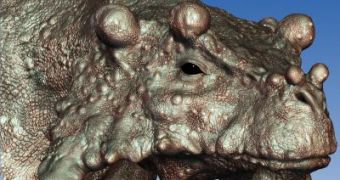A team of researchers writing in a recent issue of the Journal of Vertebrate Paleontology detail the discovery of several fossil remains which they say were left behind by a cow-like reptile that roamed the Earth some time before the dinosaurs' heyday.
The remains, dating back approximately 260 million years, were unearthed in present day Niger, Africa.
A picture of this reptile, as imagined by an artist based on information provided by paleontologists, is made available next to this article.
Though the creature will likely strike most people as plain ugly, the paleontologists who found its remains describe it as “beautifully bizarre,” EurekAlert reports.
As noticeable in the picture, the reptile sported odd growths not all that different to tumors on both its head and its back. Hence the fact that its genus is called Bunostegos, which reportedly means “knobby roof.”
“Imagine a cow-sized, plant-eating reptile with a knobby skull and bony armor down its back,” reads a statement issued by researcher Linda Tsuji.
Paleontologists say that this bovine-like creature used to call home a desert located in the central part of the supercontinent Pangea.
It appears that, due to climatic conditions, this particular region was isolated from the rest of the continent and housed several other odd species.
“Our work supports the theory that central Pangea was climatically isolated, allowing a unique relict fauna to persist into the late Permian,” study leader Dr. Christian Sidor explains.
“It is important to continue research in these under-explored areas. The study of fossils from places like northern Niger paints a more comprehensive picture of the ecosystem during the Permian era,” he wishes to stress.
Interestingly enough, several other fossils of other creatures whose bodies were covered in tumor-like growths have been discovered in this part of the world over the past few years, Daily Mail says.
Specialists have labeled these creatures as “cousins” of the Bunostegos whose remains they have recently unearthed in Niger, and say that their bulbs pale in comparison to those that used to adorn the head and the back of the newly discovered specimen.

 14 DAY TRIAL //
14 DAY TRIAL //